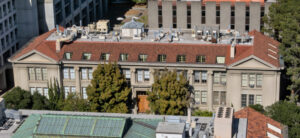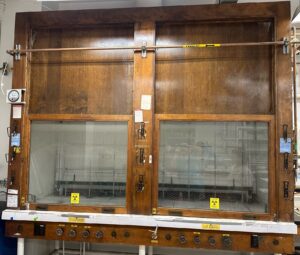For folks that haven’t been lucky enough to experience the “Phil Points At Things That Aren’t There Anymore” Manhattan Project Tour of Berkeley, there is a secondary bit of education that comes courtesy of having 160 years worth of chemistry buildings still standing to point at. I similarly do this for students when getting them to really consider the work they are doing so the appreciate the gear they have, care for it and USE IT. It goes like this:
You don’t have electricity, you barely have plumbing. Nothing in this lab around us except for the glassware exists. No pipette. No magnetic stirring hot plate. No mostly inert polyethylene counters and worksurfaces. No PPE to wear other than leather smocks and gauntlets. No fume hood. How do you safely do your work without horrible exposure and early death? The processes you’re doing are likely 19th century or earlier in vintage, so how would you do it?
Honest answer a lot of the time was “Get someone else expendable and common to do the nasty bits/manual labor and, if too precious and gentlemanly, do it yourself, hope for the best and accept the shortened lifespan as a worthy sacrifice on the altar of Natural Philosophy.” There is a reason that as recently as the 1960s the average lifespan of chemical engineers was roughly 45 years from the actuarial tables. I blame crucibles of boiling BeO with no ventilation to speak of but that’s several decades past the point they should have. As I’ve said many many times, our ancestors weren’t dumb; they just had different tools and mores than us. They knew toxic when they saw people drop dead. They may have not known specific metabolic pathways but they understood cause and effect, naming various “industrial diseases” for the tasks, not the poison, not the cancers. Things like fossy jaw, tinknockers’ disease, various metal fevers, and foundry blindness. At the research level, which was generally an aristocrat’s game across most nations in the last 300 years, the answer was to do your work outside or in a very open air environment like a particular drafty walls optional/easily blown off shed or a forge. You may be familiar with such designs from modern practitioners of the art.
(Tom is a friend. “Jank Science” is his style, very proud of being able to do what he does with meager items & gear from the pool supply store and lab trash bin. Fairly safely at that.)
A forge is actually important to the next step of safety control evolution. When you’re working with something nasty and toxic, you want those fumes/vapors/gas drawn away from you. You could have a dedicated person to blow bellows or wave a fan at you, but that’s not great nor is it necessarily enough to overcome the breeze that might blow it right back at you. A forge had a chimney to draw the smoke from blacksmithing and a potentially intense heat source as well. And so, people liked to do their work on the hearth in front of a fireplace with a low fire to generate the draw to pull vapors up the chimney and away from the workspace. This also had the benefit of allowing you to work indoors which is nice during the colder months of the year and in bad weather. The indoor lab’s first safety feature is born!

If you have a pre-1900s building on your campus, look for the building with A LOT OF CHIMNEYS. Like, way more than you think any building should have for mere comfort. That building is likely the 18th or 19th century home of the chemistry department. At UC Berkeley, that is South Hall, the original sciences building (this picture does not do justice to how many goddamn chimneys it has). For ease of evacuation, the chemistry labs were on ground floor. This is normally a good idea, except there were four floors and those chimneys connected to a fireplace on each floor. Depending on wind, nasty things might not go straight up the chimney; instead it might get shoved back out into the offices of physics and geology professors on the 2nd, 3rd, and 4th floors. As soon as possible, the chemistry department was exiled to a new building entirely dedicated to them called Hildebrand Hall. Not the one that’s there now, AKA New Hildebrand, but Old Hildebrand; all that remains of it is the gingerbread house dovecote, which used to be at the top of the building, sitting in the plaza.

Changes in architecture can the dictate changes in practice and vice versa. Never underestimate how much Style & Cool play in safety applications. A colleague once had a surgeon tell them point blank “I’d rather be blind than wear those (laser safety eyewear). Then I wouldn’t have to see them.” A few decades on from the mid-19th century French styles of South Hall and the giant wooden gingerbread house of Old Hildebrand, amazing innovations in plumbing, structural steel, concrete, and electrification had happened bringing Gilman Hall into the world. The other thing that had happened to UC Berkeley was Julia Morgan and the Spanish Revival style with the California School of Mines, AKA Hearst Memorial Mining Building. From both a chemistry and California point of view, this is great because a terra cotta tile roof is very hard to light on fire and “Do what Julia did” sorta turned into the design motif for several subsequent decades of buildings. But see those notches in the roofline of Gilman and the building the foreground with the windows that open into the rooms? They’re called dormers and one of the things we had learned to do since South Hall was to get rid of the fireplaces & chimneys and to banish the nasty chemistry to these spaces. While you don’t have a chimney to draw fumes away, you have the convenient outdoor workspace to shove shit out onto and close the windows or, if you can’t and need to work fast, you can set up one of these newfangled desk fans to blow things out. Some buildings with dormers elsewhere I’ve seen had more complicated enclosures that I will describe as “greenhouse like” to help you shove the nasty things into and vent them outside, rather than the workspace with humans in it.
This brings us to the postwar 1940s. In the wake of the Manhattan Project work done with dormers as state of the art ventilation and exposure control, the newly formed Atomic Energy Commission tasked the Harvard School of Public Health with finding a way to control ventilation, filter airborne contaminants, and minimize emission and general crapping up of absolutely everything. The result of this were the first HEPA filters. At Berkeley, these HEPA filters merged with the dormer enclosures and added ducting & fans to pull air away from workers, through filters, and exhausted far away on the roof. This first generation of chemical fume hoods were derisively known as Berkeley Boxes, with the implication you weren’t doing manly Real Science if you were using those. The dramatic drop in exposures, hospitalizations, and early career aggressive cancers lead to fume hoods being widely adopted very quickly and the negative connotation going away. The sash and plenum design of fume hoods, in an improved but still recognizable form little changed in 75 years, are still referred to as Berkeley hoods in the industry.

Which is why this entire post was written. Last Friday, I remembered to take a picture of one of the two surviving earliest Berkeley Boxes. If you have some experience of chemical fume hoods, you might be scratching your head at the choice of materials to make this one, plus the many retrofits made over the decades to bring it up to evolving standards. Some things you grandfather in other things, like the hoods you handle radioactive materials in, you don’t. This one is slated for demolition to be replaced by something newer and actually functional. This is one of the bittersweet things I learned long ago in my History of Science & Technology class, that in the progression of technology and processes we quite deliberately do not preserve the previous iterations. The fume hood isn’t the science, it’s one of the tools you need to do science safely; you need it functional and upgrade as needed/when you can and space is at too much a premium to lose to old broken stuff. This particular Berkeley Box has held on as long as it has because it was good enough for teaching purposes and there was no money or need for better. This isn’t a landmark or anything but it’s important to document and remember, like I’m doing here, of where we’ve been and why things are like they are now.
Don’t mourn this Berkeley Box. Appreciate it for the many decades of work it did teaching generations of students, being replaced by a better modern fume hood it paved the way for.